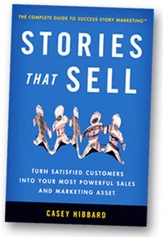>
Guest post by Casey Hibbard
Stop Tooting Your Own Horn – Let Customers Say it for You
When business owner Linda McCulloch looked to set her marketing and creative firm apart from the competition, she didn’t want to take the same tired approach – “telling everyone how great you are.” Instead, she turned the spotlight on her successful customers.
Linda, of Atlanta-based Design That Works, collected the success stories of some of her happiest clients – highlighting their results of working with the firm – and began featuring them in all of her marketing and sales efforts:
·On her web site
· In direct mail postcards
· In a multi-story booklet that replaced her traditional company brochure
· And even in one-on-one meetings with potential clients
The results paid off. Those stories consistently engage her audience, helping her generate awareness and close sales. It’s a powerful – and necessary – approach.
In the age of the jaded customer, where many expect to read Amazon, eBay or similar reviews before making purchases, your potential customers want third-party validation. Ideally, they know a friend or family member that can vouch for you. But if not, they’ll settle for hearing from strangers that have firsthand experience with you. They’ve heard the promises. Now they want to know the reality.
Stories provide essential credibility, educate prospects, and validate that your product or service actually delivers as promised.
As you look at your ’09 marketing plans, here are seven steps to help your customers say it for you:
- Decide what kinds of customers you want more of (by size, industry, geography, age, etc).
- Pick 5 to 10 current customers that closely mirror the same mix of customers you want more of.
- Ask customers if they are willing to talk publicly about their experiences, reinforcing that it will be a positive story featuring them (free publicity). Or, post a form on your web site allowing customers to nominate themselves as successes and submit their stories.
- Engage a writer or videographer (or do it yourself if you have the skills) to capture the story.
- Interview customers by phone or in-person, asking why they needed your product/service, why they chose you, how they use the product/service, and the end results. Get specifics.
- Pull those stories into attractive formats with graphics or customer photos.
- Use your customer stories every way that you can within your budget.
Electronically – Web site, emailed PDFs to prospects, featured on your blog, in your email newsletter, direct email campaigns, sales proposals, in PowerPoint presentations, in press releases. You might even pull out a bullet-point result and mention it when leaving voice mails for prospects.
Printed – Handouts at trade shows, leave-behinds in sales meetings, mailed separately with a sales letter, abbreviated in a sales letter, direct mail.
Video – On your web site, video sites, playing in your trade show booth, playing at your physical location.
The idea is to infuse all your marketing and sales with the credible and compelling voice of your happiest customers.
Casey Hibbard of Compelling Cases Inc. is author of Stories That Sell: Turn Satisfied Customers into Your Most Powerful Sales & Marketing Asset. For more tips on creating and using customer stories, sign up for a monthly e-tip or the Stories That Sell blog at www.storiesthatsellguide.com.
Related articles on customer stories:
Writing Customer Stories
The Experience Economy
A Remarkable Customer Experience
For updates on new articles: Receive The Marketing Spot by Email or ![]() Get The Marketing Spot in a blog reader
Get The Marketing Spot in a blog reader

